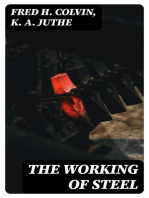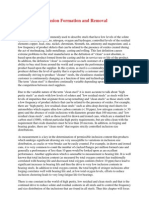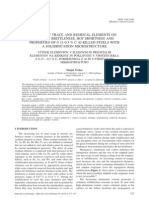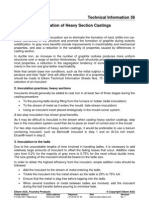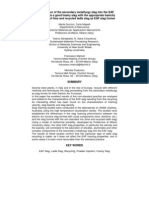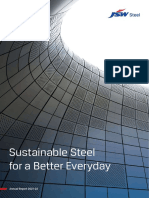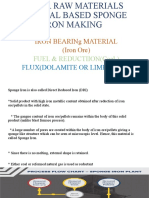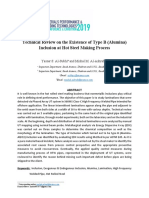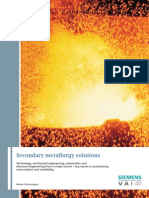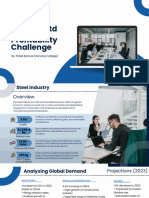Clogging in Continuos Casting Nozzle
Clogging in Continuos Casting Nozzle
Uploaded by
miltone87Copyright:
Available Formats
Clogging in Continuos Casting Nozzle
Clogging in Continuos Casting Nozzle
Uploaded by
miltone87Copyright
Available Formats
Share this document
Did you find this document useful?
Is this content inappropriate?
Copyright:
Available Formats
Clogging in Continuos Casting Nozzle
Clogging in Continuos Casting Nozzle
Uploaded by
miltone87Copyright:
Available Formats
Rackers, K., and B.G. Thomas.
78th Steelmaking Conference Proceedings, Nashville, TN, April 2, 1995, Iron and Steel Society, Warrendale, PA, Vol. 78, 1995, pp. 723-734.
Clogging in Continuous Casting Nozzles
K. G. Rackers and B. G. Thomas Department of Mechanical and Industrial Engineering University of Illinois 1206 West Green Street Urbana, IL 61801
ABSTRACT Nozzle clogging is a serious productivity and quality problem in continuous casting. This work reviews the causes, effects, and solutions to clogging in continuous casting nozzles. The results of a one-dimensional, steady state analysis of the heat loss from the molten steel stream through the nozzle wall are discussed. The analyses show that steel may freeze within the clog matrix for a relatively small clog buildup. The implication of this result on the mechanism of clog growth and on clogging mitigation techniques is discussed. 1, INTRODUCTION 1.1. Importance of Clogging Clogging in continuous casting nozzles is the buildup of material in the flow passage between the tundish and mold (see Figure 1.). The consequences of clogging include: Decreased productivity. To compensate for clogging, the flow control device (e.g., slide gate) must be further opened. If the clogging becomes sufficiently severe, the flow control device will no longer be able to compensate and then either a decrease in casting speed or replacement of the nozzle must result. These events reduce the net casting throughput and thereby reduce productivity. Increased cost. Depending on the casting shop, some portions of the clogged nozzles (e.g. submerged entry nozzle) can be independently replaced during casting. Other clogged portions (e.g., tundish nozzle) can only be replaced by changing tundishes. Several authors report that nozzle clogging, in lieu of tundish lining lifetime, limits the allowable tundish lifetime [1, 2]. For example, Haers et al. reported that clogging reduced the number of heats (290 tons) cast from twelve to six [3]. Therefore nozzle clogging results in additional costs for tundish refurbishment as well as for nozzle replacement
Decreased quality. Nonmetallic particles can become dislodged from the clog buildup and result in unacceptable cleanliness defects in the product, especially in deep drawn applications requiring oxides be smaller than fifty microns in diameter [4 - 11]. The restriction of the flow passage may also cause undesirable flow patterns in the mold which thereby cause quality problems (e.g., mold flux ingestion, shell thinning) [6, 12 - 14]. Also, the mold level transients occurring when a tundish is replaced due to tundish nozzle clogging, can cause reduced quality [3]. 1.2. Types of Clogs There are four general types of clogging, each from a different origin. In practice, clogging within a single nozzle could be due to a combination of two or more types. The classification chosen here distinguishes between clogs consisting of deoxidation products, solidified steel, complex oxides, and reaction products. 1.2.1. Agglomeration of Deoxidation Products - Buildups consisting of deoxidation products (e.g., alumina, titania, zirconia) have been observed in the nozzles. These deoxidation products are of the same composition and size (typically 1 - 20 micron [10, 15 - 17]) as is found in the mold [10, 16]. The deoxidation products sinter together to form a network [18 - 20, 16]. This sintered matrix may or may not encompass steel. Steel has been found within the matrix for heats with low residual deoxidation product content, as might be found when using DH degassing or for high carbon concentrations [10, 14]. No steel is found within the matrix when the deoxidation product concentration is high, as might be found when using argon bubbling during secondary refining and low carbon concentrations (e.g. less than 0.10% C) [10, 14]. 1.2.2. Solid Steel Buildup - If the superheat is low, and the heat transfer from the stream is high, the steel may freeze within the nozzle. This is especially true at the start of cast if nozzle preheat is inadequate [21]. 1.2.3. Agglomeration of Complex Oxides - Clogs containing nonmetallic materials not resulting from deoxidation have also been observed. Clogs have been observed in the submerged entry nozzle port area which have a chemistry indicative of a combination of mold flux and deoxidation particles. Here it is believed that the mold flux is drawn into the top of the ports due to the recirculation flow pattern in the upper part of the mold and due to the tendency of the flux to coat the nozzle [14, 22]. Once inside the nozzle, the flux assimilates deoxidation particles, thereby increasing the clog volume [6]. Clogs containing calcium aluminates or calcium sulfides have also been observed on calcium treated heats [5, 11, 15, 23 - 25]. The effect of calcium on clogging will be discussed later in reference to clogging mitigation efforts. 1.2.4. Reaction Product Buildup - Clogging with the composition of deoxidation products but deposited in a film instead of a sintered network of particles has been observed. The source for these buildups has been attributed to reactions between the deoxidant and 1) air drawn into the nozzle due to the negative gauge pressure and the porosity of the nozzle [19, 26], 2) oxygen evolved from the steel due to the lower steel temperature adjacent to the nozzle [27], and 3) oxygen generated by silica refractory
decomposition [18, 19, 26, 28, 29]. These mechanisms are consistent with the reported observations of increased clogging as soluble aluminum concentration is increased [4, 30]. 1.3. Causes of Clogging For those clogs consisting of solidified steel or reaction products, the transport and attachment mechanism are straightforward because the clogging phenomenon takes place at the nozzle wall. But for clogs containing deoxidation products, the process of their transport and attachment is more complicated. 1.3.1. Transport of Deoxidation Products to the Nozzle Wall - Several theories have been proposed concerning flow patterns and geometries which enhance transport of deoxidation products to the nozzle wall: Turbulent Recirculation Zones. Within a recirculation zone, turbulent velocity fluctuations oriented in all directions are present. Those fluctuations toward the wall will enable deposition [31]. Turbulent Flow. Turbulent eddies, even in the absence of a recirculation zone, will transport deoxidation products to the nozzle wall [17]. Rough Nozzle Walls. As the roughness of the nozzle wall is increased (e.g., due to irregular buildup or erosion) the probability of interception of entrained deoxidation particles increases [11, 31, 32]. External Corners. Since the density of alumina is less than steel, alumina will tend to be driven toward the wall for flow around an external corner (e.g., tundish nozzle entry). This driving force is expected to be significant only for large alumina particles (e.g., 36 micron [17]). 1.3.2. Attachment of Deoxidation Products to the Nozzle Wall - Deoxidation particles are attached to the nozzle wall by surface tension and, after sufficient time, by sintered bonds. The surface tension of the steel creates a void and, consequently, an attractive force between the deoxidation product and the wall (or another deoxidation product) [10, 33]. The magnitude of this force for the case of a 2.5 micron deoxidation product attaching to a ceramic filter has been calculated to be approximately an order of magnitude greater than the drag and buoyant forces on the particle [20]. The sintered bond between the particle and wall (or another particle) forms relatively rapidly at these temperatures (e.g., only 0.03 seconds is required for two ten micron particles to develop a sufficient neck between them to withstand drag and buoyant forces [20]). 1.4. Ways to Avoid Clogging The most obvious means to reduce clogging is to decrease the concentration of deoxidation products and the formation of reoxidation products [4, 10, 14, 23, 34, 35]. Means to achieve this increase in steel cleanliness have been reviewed by Byrne et al. and Szekeres [6, 14]. The important aspects of clean steelmaking include:
Ladle Refining Practice. A vacuum degassing treatment yields better cleanliness than does argon bubbling [36]. Reoxidation Prevention. Submerged ladle-to-tundish pouring, shielded tundish surface, and leak-tight refractory joints will reduce exposure of the steel to oxygen and thereby improve cleanliness [14]. Deoxidation Product Removal. Optimal tundish flow patterns [37] as well as filtration [20, 33, 38] and electromagnetic techniques [39] can remove deoxidation products from the melt. Flux Entrainment Prevention. Submerged ladle-to-tundish pouring and avoidance of ladle slag carryover will reduce the amount of exogenous inclusions in the melt [6, 14]. It is unlikely that steel cleanliness improvements will completely eliminate nozzle clogging. Dawson calculated that for typical casting conditions, nozzle blockage could occur if as little as one in every 1500 nonmetallic inclusions were deposited on the nozzle [31]. To reduce the deposition of the entrained deoxidation products, several techniques have been utilized as discussed below. 1.4.1. Argon Injection - Argon injected through the nozzle wall or stopper rod into the steel stream is widely employed to reduce nozzle clogging. A typical injection rate is 5 five liter/minute (STP) [27, 40]. Several reasons have been suggested for the improved clogging resistance: A film of argon is formed on the nozzle wall which prevents the deoxidation product from contacting the wall [41, 42, 43]. The argon bubbles flush the deoxidation products off the nozzle [43]. The argon bubbles promote the flotation of deoxidation products [19].
Argon injection increases the turbulence and thereby causes the deposit to be flushed off [35]. It is noted that this mechanism contradicts a previously mentioned hypothesis which states that turbulence enhances deposition. The pressure inside the nozzle is increased which thereby reduces air aspiration through the nozzle [14, 43, 44]. In the absence of argon injection, negative gauge pressure has been measured in water models near the slide gate and the stopper rod seating surface [43]. The argon prevents a chemical reaction between the steel and the refractory [19].
The argon can be injected through the pores in the refractory material [1, 2, 18, 41, 42, 44] or via machined or laser cut holes in the refractory [7, 18, 19]. Tailoring the argon flow to be greater in areas of high deposition [18, 44] and to be locally uniform [2, 44] has been shown to reduce clogging. Disadvantages of argon injection include increased quality defects and nozzle slag line erosion due to the increased mold level fluctuations [14, 27], bubble entrapment by the shell [8, 14, 44], and nozzle cracking due to high back pressure or decreased nozzle thermal shock resistance [1, 18, 44]. It is also suspected that argon injection tends to move the clogging problem to a different location [32].
1.4.2. Calcium Treatment - Alumina clogging can be reduced by adding calcium to the steel to prevent the formation of solid alumina [30, 45, 25, 46]. As shown in Figure 2, for a typical melt temperature of 1550 C, liquid is the equilibrium phase for calcia-alumina mixtures containing 40 - 60% alumina. Furthermore, it is believed that under steelmaking conditions, mixtures containing a higher fraction of alumina will be also be liquid. This is based on the observation that when CaO2Al2O3 inclusions (79% alumina) are found in the final cast product, these inclusions take a spherical form and the nozzle experiences much less clogging [24]. The disadvantages of calcium treatment include: Increased clogging relative to the non-treated condition if insufficient calcium is added, due to the formation of CaO6Al2O3 [17, 24, 25]. Erosion of refractories [5, 14, 27].
Also, calcium treatment will not work for high sulfur steels because calcium will react with sulfur to form solid calcium sulfide instead of liquefying the alumina [11] (e.g., sulfur must be less than 0.007% for a typical total aluminum concentration of 0.04% [47]). However, it has been proposed that calcium treatment might still be successful if the sulfur is added after calcium treatment [32]. 1.4.3. Nozzle Material Modifications - A variety of nozzle compositions have been investigated. Calcia additions to the nozzle [10, 48, 49, 50] have yielded decreased clogging by liquefying the inclusions, as discussed above. The effectiveness of this method is limited by the diffusion of the calcia to the refractory surface [50]. Other compositions and coatings have also been attempted [1, 3, 29, 32, 40, 51, 52, 53], but the cause for the decreased clogging is uncertain. For example, the addition of boron nitride has been shown to markedly reduce clogging [29, 32, 40]. However, it is not known whether the beneficial effect of boron nitride is due to the formation of a liquid boron oxide film [29], decreased surface roughness [31], or another cause. Other possible explanations for the observed clogging reduction of the various materials investigated are decreased thermal conductivity [51, 52, 53], decreased contact angle with steel [29, 51, 52], reduced reactivity with steel [26], and decreased air aspiration [3]. 1.4.4. Nozzle Geometry Modifications - In an effort to reduce the effect of clogging, oversized nozzle bores [3, 54] and replaceable submerged entry nozzles [3] are widely employed. To reduce the degree of clogging, the following have been investigated: Improved joint sealing. Strengthening the steelwork that holds the nozzle in place was found to reduce air aspiration and thereby reduce clogging [18]. Rounded nozzle entrance. Incorporating a rounded entrance (in lieu of a sharp corner) to the tundish nozzle and ensuring proper vertical alignment can reduce clogging at the nozzle entrance by eliminating separated flow [31].
Internal step. A five millimeter annular step incorporated at the mid-height of the submerged entry nozzle has been found to decrease alumina buildup in the lower part of the nozzle as well as decreasing flow impingement on the mold wide face [55]. Varying nozzle internal diameter. Increasing the nozzle internal diameter just below the stopper rod seating surface has reduced clogging [14, 56]. Flat bottomed nozzle. Decreased port clogging was observed when the elevation of the nozzle internal bottom and port bottom were coincident (i.e., no nozzle well) [55]. Insulation around nozzle. Insulation, as well as preheat and heating, around the clogging location may reduce clogging [14]. 2, INITIAL MODELING EFFORTS The first steps we took to understand nozzle clogging were to develop simple models of the various aspects of the clogging process. Described below are models which predict the strength of the clog buildup and the role of heat transfer in reinforcing the clog buildup. In addition, the relationship between slide gate position and degree of clogging, the effect of clogging on air aspiration, the deposition rate of deoxidation products, and the role of reoxidation in clogging are discussed. 2.1. Strength of the Clog The clog matrix has been described as a powdery friable buildup that could be easily removed by the touch of a finger [16]. To explain the ability of this buildup to withstand erosion by the molten steel, Duderstadt [68] proposed that the clog was strengthened by solid steel dendrites which grew radially inward due to heat loss through the nozzle wall. However, essentially pure alumina buildups have been observed in practice [4, 10]. Furthermore, Ogibayashi et al. [10] claimed that the steel within the clog matrix is liquid during casting as evidenced by the observation of pure alumina clogging and alumina clogging with entrapped steel both appearing in the same region. As mentioned above, Ogibayashi et al. concluded that the presence of pure alumina or alumina embedded in steel will be determined by the steel cleanliness (i.e., concentration of alumina in the steel). Two questions that are prompted by the above observations are: 1) How dense must a clog matrix be to withstand erosion? 2) How can steel cleanliness determine the clog morphology? In other words, if clog growth is envisioned as the entrapment of entrained deoxidation products by the clog matrix, then how does the rate at which the deoxidation products are entrapped (which will clearly be a function of concentration) affect where the deoxidation products are entrapped? In fact, since the ejection of the steel from between the deposited deoxidation products [10] requires finite time, one might expect that the dirtier the steel the greater the amount of steel entrapped within the clog. Simplified models to address these issues were developed and are discussed below:
2.1.1. Erosion of an Alumina Buildup - The simplest model developed was that of a single finger of alumina protruding radially into the bulk flow. If I restrict my attention to areas with a uniform mean flow (e.g., ignore boundary layers and separation zones), I can treat this as an alumina rod subjected to a distributed load resulting from the drag force imposed by the molten steel flow (Figure 3). Assuming a bulk flow of 1.6 m/s (corresponds to 3 ton/min through a 76 mm diameter nozzle bore), alumina failure stress of 300 MPa [20], and drag corresponding to flow past a cylinder; the maximum length of a 10 micron diameter rod would be 0.5 mm (i.e. at this length the outer fiber bending stress would exceed the failure stress). Clearly, even if the inclusions were completely sintered together, the buildup must be greater than one inclusion in diameter to reach the extent of clogs observed in practice. For the buildup to extend 20 mm radially into the bore, the alumina rod must be 0.26 mm in diameter. The pure alumina clogs observed in practice will still have significant spacing between the deposited particles. Therefore, the buildup must be thicker than the value predicted above to offset the reduction in effective strength. The above model was modified to account for a buildup containing a volume fraction of 17% alumina (based on surface tension arguments as discussed below). For this porous buildup to extend 20 mm radially into the bore, the alumina rod must be 0.62 mm in diameter. Note that in both cases, buildups of significant length will survive if the buildup is only a fraction of a millimeter wide. If the deposition process is considered as the addition of deoxidation particles to random locations on a clog matrix, then it can be concluded that only a fraction of the buildup fingers will have sufficient cross-sectional area to continue growing. It also follows that the fraction of the buildup fingers that continue to grow will be greater if their unsupported length is decreased by solidified steel. 2.1.2. Steel Reinforcement of the Alumina Matrix - To determine whether the steel within the matrix solidifies during casting, a one dimensional, steady state heat transfer model of the submerged entry nozzle was developed (Figure 4). The Sleicher and Rouse correlation [57] was used to predict the heat loss from the molten steel stream. Heat transfer through the clog and nozzle wall was assumed to be via conduction only. Heat was lost to ambient by radiation. The dimensions, material properties, and casting conditions considered are shown in Table I. For a sufficiently large clog thickness, the entrapped steel adjacent to the wall will freeze. The effect of clog thickness on the frozen steel (i.e., skull) thickness is shown in Figure 5. It is seen that for clog thicknesses greater than 3.5 mm, skulling will occur. The effect of varying the assumed parameters (see Table I) on the skulling behavior can be seen in Figure 6. It is seen that the conductivity of the refractory and the freezing temperature of the steel have a large effect on the degree of skulling. The freezing temperature will be a function of the concentration of solute at the interface. To estimate the solute concentration at the interface, a transient solidification analysis was accomplished (see Figure 7). The concentration profile ahead of the interface was approximated as the profile which would result from a constant interface velocity and a quiescent melt. Latent heat evolution was accounted for and sensible heat loss was neglected. An explicit time stepping algorithm was used to track the interface position.
As shown in Figure 8, the constant growth rate assumption is consistent with the predicted solution after the initial transient. However, solute convection is expected to be non-negligible for low growth rates (e.g., for an interface velocity of 5 mm/hr, the concentration boundary layer thickness = D/V = 14 mm). This will tend to increase the growth rate from the predicted values. Considering only superheat removal, the sensible heat loss is negligible compared to the latent heat loss (i.e., Stefan # = .07). The net results of the transient analysis are shown in Figure 9. It is seen that as the clogging rate increases, the distance between the clog front and the solidification front increases (e.g., for a final clog thickness of 20 mm, increasing the deposition rate from 1 to 20 mm/hr decreases the final skull thickness by 4 mm). The steady state prediction curve shows the predicted steady state skull thickness using the interface temperature obtained from the transient analysis. By comparing the two curves, it is seen that the skulls are approximately at the steady state temperature distribution. A steady state analysis of the tundish nozzle was also accomplished. The steady state submerged entry nozzle model was modified to include an additional steel shell outside of the nozzle (to represent the mounting block) and an intervening gap (Figure 10). The additional parameters are shown in Table I. As seen in Figure 11, in spite of the increased thermal resistance, skulling is still observed when the clog thickness is greater than 4 mm. The reason that the increase in thermal resistance has such a small effect on the skulling behavior is that the heat transfer area between the nozzle assembly and ambient also increases. Figure 12 shows that increasing the mounting block thickness from 100 mm to 300 mm will actually result in a small increase in skull thickness. These analyses indicate that skulling may be an integral part of the clogging mechanism in some regions. Skulling would enable inclusion deposits of smaller width to survive by reducing their unsupported length. Since this would reduce re-entrainment of the clog matrix by the molten steel stream, it would increase the clogging rate. Also, skulling may help explain how steel cleanliness effects the quantity of entrapped steel in the clog. As the cleanliness is degraded, the deoxidation product deposition rate will increase, thereby causing the distance between the solidification front and the clog front to increase. This will enable the clog matrix, which acts like a filter, to capture more deoxidation products and expel liquid steel. Furthermore, the density of the buildup will be necessarily higher to prevent failure of the longer unsupported buildup length. If the volume fraction of alumina within the matrix becomes high enough, then all the steel within that region of the clog will be expelled [20]. The effect of skulling on clog growth will be greater during some casting transients (e.g., initiation and interruption of casting) due to low nozzle or melt temperature. During these transients, skulling will not only increase the strength of the clog matrix, but may outpace the clog front and extend into the bulk flow. This might be especially important at initiation of casting since it would increase the effective wall roughness and therefore increase deoxidation product capture. Whether skulling occurs during steady state or transient casting conditions, the rate of its remelting (if the temperature is subsequently increased) will be limited by the rate of carbon diffusion to the interface. 2.2. Other Modeling Results
To determine the relative importance of various phenomena, a number of additional models were developed, as discussed below: 2.2.1 Nozzle Flow Model - The only measure of clogging during the cast is the slide gate or stopper rod position. A crude model of the tundish nozzle, slide gate, and submerged entry nozzle was developed to quantify the relationship between slide gate position and degree of clogging. The tundish nozzle and submerged entry nozzle were modeled as a rough pipe whose radius was decreased by an amount equal to the clog thickness. The nozzle ports were modeled as a tee. The slide gate was modeled as an orifice of equivalent cross section and subsequently adjusted to better match caster data. The pressure drop due to flow acceleration at the tundish nozzle entrance was determined using Bernoullis equation. The casting conditions considered are given in Table II. Table II. Fluid Flow Analysis Parameters Parameter Density Tundish Melt Height Nozzle Submergence Depth Tundish Nozzle Length Submerged Entry Nozzle Length Nozzle Inner Diameter Nozzle Surface Roughness Port Resistance Coefficient Value 7015 kg/m3 1203 mm 203 mm 343 mm 840 mm 80 mm 0.5 mm 0.8 Source [62]
50 mm Dia. Tee [64]
The relationship between degree of clogging and the slide gate position required to maintain the casting rate is shown in Figure 13. It is seen that very little slide gate travel is required until the clog reaches a critical thickness. After reaching the critical thickness, a small increase in clog thickness necessitates a large change in slide gate position. The underlying reason for this behavior is that for a fixed casting rate, the turbulent pressure drop through a rough pipe is inversely proportional to the fifth power of the pipe radius. This result indicates that slide gate position is generally a poor indicator of the extent of initial clogging. This analysis was also utilized to predict conditions and regions at which air aspiration were most likely to occur. Figure 14 shows the gauge pressure within the tundish and submerged entry nozzles for a casting speed of 4 ton/min and three different clogging conditions. The first condition represents casting through a nozzle with no clogging. As expected, the majority of the pressure drop for this case is due to the slide gate. Note that the pressure in the upper half of the submerged entry nozzle is predicted to be below atmospheric pressure, making this region susceptible to aspiration. These results are in good qualitative agreement with the measurements of Heaslip et. al. [43] who performed a series of water modeling experiments which quantified the effect of gas injection on the pressure distribution. Additional work is planned to simulate the specific casting conditions he considered.
The second condition considered represents a tundish and submerged entry nozzle with a limiting amount of clogging (i.e., the required slide gate position to maintain cast speed is 100%). It is noted here that the pressure everywhere remains above atmospheric. The final case considered represents limiting clogging in the tundish nozzle and no clogging in the submerged entry nozzle (e.g., the condition after a submerged entry nozzle replacement). For this case the entire tundish nozzle is below atmospheric pressure. 2.2.3. Fraction Alumina Captured by Nozzle When no clogging countermeasures are employed, nozzle clogging has been observed to limit sequence casting to 1-3 heats [1, 45]. Assuming 250 ton heats and a 30 ppm combined oxygen concentration in the tundish, 32 kg of alumina will pass through the nozzles in two heats. The density of a pure alumina clog will depend on the packing efficiency of the deoxidation products. If the clog is modeled as a group of 10 micron diameter finger-like structures (see Figure 15) and the critical distance between the fingers for ejection of molten steel is calculated [10], the volume fraction of alumina in a pure alumina clog is 17%. Considering a two strand caster [1] having 1 m long nozzles with 20 mm thick clogs, the amount of alumina within the clogs is calculated to be 5.1 kg. Taking the ratio of the deposited alumina to the alumina throughput, it is seen that in these severe clogging situations about 16% of the alumina passing through the nozzle is deposited (assuming the clog is composed of deoxidation products). This indicates that in the absence of clogging countermeasures (e.g., argon injection), transport of the inclusions to the nozzle wall is fairly efficient. 2.2.4. Relationship between Reoxidation and Clogging Rate Nitrogen pickup between the tundish and mold can be used to quantify the reoxidation occurring in the nozzle [58]. Prior to efforts to improve nozzle air-tightness, McPherson [58] measured nitrogen pickup values of 5 ppm. Considering 250 ton heats and assuming all the aspirated oxygen forms alumina, this reoxidation source would generate 1.4 kg of alumina in two heats, a substantial fraction of the above calculated clog mass. The aspirated oxygen also accelerates the deposition of deoxidation products by creating a surface tension gradient around the deoxidation product which in turn causes a net force on the particle in the direction of the wall. Considering a linear variation in surface tension with position, and assuming Stokes drag on the particle, the surface tension induced particle velocity is: V= -2 m R 9 where, V = particle velocity m = surface tension gradient R = particle radius = viscosity of steel
10
Consider aspiration occurring evenly over the length of a 1 m long, 80 mm diameter nozzle which results in a nitrogen pickup of 0.3 ppm (a relatively air-tight system) [18]. Assume that the oxygen does not react with the steel or deoxidants in the vicinity of the wall. The concentration gradient needed to diffuse the oxygen through the near-wall region to the bulk flow (DO=2.5 cm2/s [56]) will in turn generate a surface tension gradient due to the effect of oxygen concentration on steel surface tension ( 5 (N/m) / (atom% O) [56]). This surface tension gradient results in a surprisingly high particle velocity of 0.9 m/s for a 10 micron diameter particle. In light of this analysis and prior publications discussing deoxidation product transport [31], it is concluded that in some regions (e.g., in the vicinity of the aspiration and outside of flow recirculation zones), this surface tension-induced transport mechanism may be the dominant mode for transporting deoxidation products to the wall. 3. SUMMARY Clogging in continuous casting nozzles results in decreased productivity, increased maintenance expense, and decreased product quality. Clogging results from deposition of deoxidation products, solidification on the nozzle wall, formation of complex oxides, or chemical reactions at the nozzle wall. These mechanisms may work together in practice. Effective clogging countermeasures include improving steel cleanliness, adding calcium, injecting argon, and eliminating flow recirculation zones. A simple steady state heat transfer analysis of the nozzle indicates that the steel within a clog buildup may freeze during casting and thereby reinforce the clog buildup. It was shown that the cleanliness of the steel may effect this solidification behavior by changing the deoxidation product deposition rate. The skulling will occur to a greater degree at initiation of casting since the nozzle and surrounding hardware will act as a heat sink. Since skulling within the nozzle will increase the clog buildup rate by reducing the amount of clog re-entrainment, actions to reduce skulling will be further investigated. Other scoping calculations indicate that clogging factors are of little use in quantifying the extent of initial clogging, air aspiration is most likely at the start of cast in the region just below the slide gate or following submerged entry nozzle replacement in the tundish nozzle (if the tundish nozzle is badly clogged), a significant fraction of the alumina in the steel is captured by the nozzle when clogging countermeasures are not employed, and air aspiration into the nozzle can account for a significant fraction of the clogging and promote deposition of deoxidation products. ACKNOWLEDGMENT The authors are grateful to Inland Steel, LTV Steel, Allegheny Ludlum, ARMCO Inc., BHP, and the NSF (Grant # DDM-8957195), for support of this work. In particular, we would like to thank R. Gass of Inland Steel for providing clogging samples and casting data as well as insights to the mechanisms of clogging. We would also like to thank D. Janssen and G. Sundy of Vesuvius for their helpful discussions on nozzle clogging. REFERENCES
11
1. L. T. Hamilton, Technical Note - The Introduction of Slit Submerged Entry Nozzles to No. 1 Slab Caster, BHP International Group Pt. Kembla, NSW, Bull. Proc. Austras. Inst. Min. Metall., Vol. 290, No. 8, 1985, pp. 75-78. 2. M. Schmidt, T. J. Russo, and D. J. Bederka, Steel Shrouding and Tundish Flow Control to Improve Cleanliness and Reduce Plugging, 73rd ISS Steelmaking Conference, Detroit, MI, March 1990. 3. F. Haers et. al., First Experience in Using the Caster Tube Change Device (TCD90), Fourth International Conference on Continuous Casting, 1988. 4. G. C. Duderstadt, R. K. Iyengar, and J. M. Matesa, Tundish Nozzle Blockage in Continuous Casting, Journal of Metals, April 1968, pp. 89-94. 5. B. Hoh et. al., Improvement of Cleanliness in Continuous Casting, Fourth International Conference on Continuous Casting, 1988. 6. M. Byrne, T. W. Fenicle, and A. W. Cramb, The Sources of Exogenous Inclusions in Continuous Cast, Aluminum-Killed Steels, ISS Transactions, Vol. 10, 1989, pp. 51-60. 7. H. T. Tsai, W. J. Sammon, and D. E. Hazelton, Characterization and Countermeasures for Sliver Defects in Cold Rolled Products, 73rd ISS Steelmaking Conference, Detroit, MI, March 1990. 8. N. Bessho et. al., Numerical Analysis of Fluid Flow in the Continuous Casting Mold by a Bubble Dispersion Model, Iron and Steelmaker, April 1991, pp. 39-44. 9. K. Tanizawa et. al., Influence of the Steelmaking Conditions on Nonmetallic Inclusions and Product Defects, 1st European Conference on Continuous Casting, Florence, Italy, September 1991. 10. S. Ogibayashi et. al., Mechanism and Countermeasure of Alumina Buildup on Submerged Nozzle in Continuous Casting, 75th ISS Steelmaking Conference, Toronto, Canada, April 1992. 11. W. Fix, H. Jacobi, and K. Wnnenberg, Collision-controlled Growth of Composites in Casting Nozzles, Steel Research, Vol. 64, No. 1, 1993, pp. 71-76. 12. M. C. M. Cornelissen et. al., The Restless Mold, Incidental Disturbances Result in Localized Product Defects, 1st European Conference on Continuous Casting, Florence, Italy, September 1991. 13. J. Herbertson et. al., Modeling of Metal Delivery to Continuous Casting Molds, 74th ISS Steelmaking Conference, Washington, D.C., April 1991. 14. E. S. Szekeres, Review of Strand Casting Factors Affecting Steel Product Cleanliness, Fourth International Conference on Clean Steel, Balatonszplak, Hungary, June 1992. 15. Y. K. Shin et. al., Construction and Start-up of a Billet Caster at Pohang Works, Ironmaking and Steelmaking, Vol. 15, No. 3, 1988, pp. 143-149.
12
16. S. N. Singh, Mechanism of Alumina Buildup in Tundish Nozzles During Continuous Casting of Aluminum-Killed Steels, Metallurgical Transactions, Vol. 5, October 1974, pp. 2165-2178. 17. F. G. Wilson et. al., Effect of Fluid Flow Characteristics on Nozzle Blockage in AluminumKilled Steels, Ironmaking and Steelmaking, Vol. 14, No. 6, 1987, pp. 296-309. 18. S. R. Cameron, The Reduction of Tundish Nozzle Clogging During Continuous Casting at Dofasco, 75th ISS Steelmaking Conference, Toronto, Canada, April 1992. 19. M. C. Tai, C. H. Chen, and C. L. Chou, Development and Benefits of Four-Port Submerged Nozzle for Bloom Continuous Casting, Continuous Casting 85, London, England, May 1985. 20. K. Uemura et. al., Filtration Mechanism of Non-metallic Inclusions in Steel by Ceramic Loop Filter, ISIJ International, Vol. 32, No. 1, 1992, pp. 150-156. 21. J. Szekely and S. T. DiNovo, Thermal Criteria for Tundish Nozzle or Taphole Blockage, Metallurgical Transactions, Vol. 5, March 1974, pp. 747-754. 22. B. G. Thomas and X. Huang, Effect of Argon Gas on Fluid Flow in a Continuous Slab Casting Mold, 76th ISS Ironmaking and Steelmaking Conference, Dallas, Texas, March 1993. 23. G. A. Demasi and R. F. Hartmann, Development of the Ladle Shroud Mechanism and its Metallurgical Benefits, The Shrouding of Steel Flow for Casting and Teeming, Iron and Steel Society, Warrendale, PA, 1986, pp. 3-11. 24. G. M. Faulring, J. W. Farrell, and D. C. Hilty, Steel Flow Through Nozzles: Influence of Calcium, Continuous Casting, Volume One, Chemical and Physical Interactions During Transfer Operations, Iron and Steel Society, Warrendale, PA, 1985, pp. 57-66. 25. B. Bergmann, N. Bannenberg, and R. Piepenbrock, Castability Assurance of Al-Killed Si-Free Steel by Calcium Cored Wire Treatment, 1st European Conference on Continuous Casting, Florence, Italy, September 1991. 26. Y. Fukuda, Y. Ueshima, and S. Mizoguchi, Mechanism of Alumina Deposition on Alumina Graphite Immersion Nozzle in Continuous Caster, ISIJ International, Vol. 32, 1992, pp. 164-168. 27. H. F. Schrewe, Metallurgy and Cleanness, Continuous Casting of Steel - Fundamental Principles and Practice, Stahl Elsen Co., 1987, pp. 100-103. 28. S. K. Saxena et. al., Mechanism of Clogging of Tundish Nozzle during Continuous Casting of Aluminum-Killed Steel, Scandinavian Journal of Metallurgy, No. 7, 1978, pp. 126-133. 29. E. Lhrsen et. al., Boron Nitride Enrichment of the Submerged Entry Nozzles: A Solution to Avoid Clogging, 1st European Conference on Continuous Casting, Florence, Italy, September 1991. 30. K. H. Bauer, Influence of Deoxidation on the Castability of Steel, Continuous Casting of Steel, Biarritz, France, May 1976.
13
31. S. Dawson, Tundish Nozzle Blockage During the Continuous Casting of Aluminum-Killed Steel, Iron and Steelmaker, April 1990, pp. 33-42. 32. N. A. McPherson and A. McLean, Continuous Casting - Volume Six - Tundish to Mold Transfer Operations, Iron and Steel Society, Warrendale, PA, 1992, pp. 11-15. 33. P. F. Wieser, Filtration of Irons and Steels, Foundry Processes, Their Chemistry and Physics Edited by S. Katz and C. F. Landefeld, Plenum Press, New York, 1988, pp. 495-512. 34. C. H. Bode, J. D. Duke, and F. J. Dewez, Design of Slab-Casting Facilities to Maximize Machine Availability, Continuous Casting of Steel, Biarritz, France, May 1976. 35. A. W. Cramb and I. Jimbo, Interfacial Considerations in Continuous Casting, ISS Transactions, Vol. 11, 1990, pp. 67-79. 36. W. T. Lankford et. al., Secondary Steelmaking or Ladle Metallurgy, The Making, Shaping, and Treating of Steel, 10th Edition, Herbick & Held, Pittsburgh, PA, 1985, pp. 671-690. 37. A. K. Sinha and Y. Sahai, Mathematical Modeling of Inclusion Transport and Removal in Continuous Casting Tundishes, ISIJ International, Vol. 33, No. 5, 1993, pp. 556-566. 38. D. Apelian and K. K. Choi, Metal Refining by Filtration, Foundry Processes, Their Chemistry and Physics - Edited by S. Katz and C. F. Landefeld, Plenum Press, New York, 1988, pp. 467-493. 39. S. Taniguchi and J. K. Brimacombe, Application of Pinch Force to the Separation of Inclusion Particles from Liquid Steel, ISIJ International, Vol. 34, No. 9, 1994, pp. 722-731. 40. E. Hffken, H. Lax, and G. Pietzko, Development of Improved Immersion Nozzles for Continuos Slab Casting, Fourth International Conference on Continuous Casting, 1988. 41. T. R. Meadowcroft and R. J. Milbourne, A New Process for Continuously Casting Aluminum Killed Steel, Journal of Metals, June 1971, pp. 11-17. 42. H. Buhr and J. Pirdzun, Development of Refractories for Continuous Casting, Continuous Casting of Steel, Biarritz, France, May 1976. 43. L. J. Heaslip et. al., Model Study of Fluid Flow and Pressure Distribution During SEN Injection - Potential for Reactive Metal Additions During Continuous Casting, Iron and Steelmaker, August 1987, pp. 49-64. 44. I. Sasaka et. al., Improvement of Porous Plug and Bubbling Upper Nozzle For Continuous Casting, 74th ISS Steelmaking Conference, Washington, D.C., April 1991. 45. J. R. Bourguignon, J. M. Dixmier, and J. M. Henry, Different Types of Calcium Treatment as Contribution to Development of Continuous Casting Process, Continuous Casting 85, London, England, May 1985.
14
46. D. Bolger, Stopper Rod and Submerged Nozzle Design and Operation in Continuous Casting, 77th ISS Steelmaking Conference, Chicago, IL, March 1994. 47. K. Larsen and R. J. Fruehan, Calcium Modification of Oxide Inclusions, ISS Transactions, Vol. 12, 1991, pp. 125-132. 48. E. Marino, Use of Calcium Oxide as Refractory Material in Steel Making Processes, Refractories for the Steel Industry, Edited by R. Amavis, Elsevier Applied Science, New York, 1990, pp. 59-68. 49. T. Aoki et. al., Alumina Clogging Resistant Materials for Tundish Shrouds, 74th ISS Steelmaking Conference, Washington, D.C., April 1991. 50. P. M. Benson, Q. K. Robinson, and H. K. Park, Evaluation of Lime-Containing Sub-Entry Shroud Liners to Prevent Alumina Clogging, 76th ISS Ironmaking and Steelmaking Conference, Dallas, Texas, March 1993. 51. L. I. Evich et. al., Experience in the Use of Chamotte Nozzles in Slide Gates in Teeming of Stainless Steel, Ogneupory, No. 11, November, 1985, pp. 44-46. 52. K. K. Strelov et. al., Clogging of the Channel of a Fosterite Nozzle in Teeming of AluminumDeoxidized Steel, Ogneupory, No. 8, August, 1985, pp. 46-49. 53. R. Szezesny, C. Naturel, and J. Schoennahl, Tundish Nozzles with a Double Layer Conception Used at Vallourec Saint-Saulve Plant, Fourth International Conference on Continuous Casting, 1988. 54. A. Jaffuel and J. P. Robyns, FLO CON Slide Nozzles, Continuous Casting of Steel, Biarritz, France, May 1976. 55. N. Tsukamoto et. al., Improvement of Submerged Nozzle Design Based on Water Model Examination of Tundish Slide Gate, 74th ISS Steelmaking Conference, Washington, D.C., April 1991. 56. W. T. Lankford et. al., The Physical Chemistry of Iron and Steelmaking, The Making, Shaping, and Treating of Steel, 10th Edition, Herbick & Held, Pittsburgh, PA, 1985, pp. 367-502. 57. L. C. Burmeister, Turbulent Flow in Ducts, Convective Heat Transfer, John Wiley & Sons, Inc., New York, NY, 1993, pp. 342-344. 58. N. A. McPherson, Continuously Cast Clean Steel, 68th ISS Steelmaking Conference, Detroit, MI, April 1995. 59. G. B. Shaw, Property Requirements for Submerged Entry Nozzles, Continuous Casting of Steel, Biarritz, France, May 1976. 60. M. N. zisik, Appendix B- Physical Properties, Appendix C - Radiation Properties, Heat Transfer - A Basic Approach, McGraw-Hill, New York, NY, 1985, pp. 736-762.
15
61. W. Kurz and D. J. Fisher, Appendix 14 - Relevant Physical Properties for Solidification, Fundamentals of Solidification, Trans Tech Publications, Switzerland, 1992, pp. 293-294. 62. C. J. Smithells, The Physical Properties of Liquid Metals, Smithells Metals Reference Book, Butterworth & Co Ltd, England, 1983, pp. 14.6-14.7. 63. W. T. Lankford et. al., Refractories for Iron and Steelmaking, Steel Plant Fuel and Economy, The Making, Shaping, and Treating of Steel, 10th Edition, Herbick & Held, Pittsburgh, PA, 1985, pp. 49, 108. 64. F. M. White, Viscous Flow in Ducts, Fluid Mechanics, McGraw-Hill, New York, NY, 1986, pp. 334.
16
You might also like
- Hardenability of High CR White Cast IronDocument4 pagesHardenability of High CR White Cast IronanruloNo ratings yet
- BF Simulation User Guide 1.00Document18 pagesBF Simulation User Guide 1.00eneskilincNo ratings yet
- Inclusion in Cast SteelDocument42 pagesInclusion in Cast SteelAnonymous w6v7JWfr5100% (1)
- The Working of Steel: Annealing, Heat Treating and Hardening of Carbon and Alloy SteelFrom EverandThe Working of Steel: Annealing, Heat Treating and Hardening of Carbon and Alloy SteelNo ratings yet
- InclusionsDocument40 pagesInclusionsricha_msmeNo ratings yet
- Slag ItroductionDocument45 pagesSlag ItroductionkidcatNo ratings yet
- Steel RefiningDocument10 pagesSteel RefiningDiana Bracamonte DyckNo ratings yet
- Fluid Flow in Tundish PDFDocument73 pagesFluid Flow in Tundish PDFPrakash SarangiNo ratings yet
- Steel Dynamics Bar Book Rev 2 New CoverDocument194 pagesSteel Dynamics Bar Book Rev 2 New CoverNina LazuardiNo ratings yet
- Reduction of The Hydrogen Content in The Continuous Casting of SteelDocument7 pagesReduction of The Hydrogen Content in The Continuous Casting of SteelBrigida Pagani0% (1)
- Advances in SteelmakingDocument189 pagesAdvances in SteelmakingAnjaniAkula100% (1)
- Project On "Caster Slab Dimensional Accuracy Technique"Document16 pagesProject On "Caster Slab Dimensional Accuracy Technique"Mayur ParvaniNo ratings yet
- Desulfurization of SteelDocument69 pagesDesulfurization of SteelPouria Homayoun100% (2)
- Chapter2 (PDF Library)Document11 pagesChapter2 (PDF Library)Pedro Lucas Menezes Lourenço100% (1)
- Determination of Inclusions in Liquid Steel After Calcium TreatmentDocument4 pagesDetermination of Inclusions in Liquid Steel After Calcium TreatmentWendel De Carvalho TôrresNo ratings yet
- Improvement of Surface Quality of Continuously Cast Steel Control PDFDocument130 pagesImprovement of Surface Quality of Continuously Cast Steel Control PDFChrist ChristiNo ratings yet
- Present Indian Steel Making Practice and Its Scenario: Introduction: WHAT IS STEEL?Document10 pagesPresent Indian Steel Making Practice and Its Scenario: Introduction: WHAT IS STEEL?SarbajitManna100% (1)
- Calcium in SteelDocument39 pagesCalcium in SteelStutee NandaNo ratings yet
- Casting Powders KemproDocument12 pagesCasting Powders KemproBhoomaiah SunkenapalliNo ratings yet
- Stainless Steel Metallurgy-Manufacturing Process, Grades & Role of Alloying ElementsDocument35 pagesStainless Steel Metallurgy-Manufacturing Process, Grades & Role of Alloying ElementsLalit MohanNo ratings yet
- Fluid Flow MoldDocument41 pagesFluid Flow MoldSimoes JBNo ratings yet
- Tempcore ProcessDocument23 pagesTempcore ProcessKumaran 1987No ratings yet
- Defects of The Steel Billet in Continuous Casting: Anh-Hoa BUI and Van-Hung NGUYENDocument6 pagesDefects of The Steel Billet in Continuous Casting: Anh-Hoa BUI and Van-Hung NGUYENafzalNo ratings yet
- Slag Presentation GrafTech 200905Document36 pagesSlag Presentation GrafTech 200905lissamariasianipar100% (4)
- Segregation and Banding in SteelDocument2 pagesSegregation and Banding in Steelsklux100% (1)
- Tramp Elements and Billet CarckingDocument7 pagesTramp Elements and Billet CarckingOmar TahaNo ratings yet
- Basic Oxygen ProcessDocument25 pagesBasic Oxygen ProcessSamanway DasNo ratings yet
- Thermo-Mechanical Treatment RebarDocument6 pagesThermo-Mechanical Treatment RebarMunna Bhai100% (1)
- Dissolution of Magnesite and Dolomite in Simulated EAF SlagsDocument14 pagesDissolution of Magnesite and Dolomite in Simulated EAF SlagsAgustine SetiawanNo ratings yet
- Casting Defects in SteelsDocument4 pagesCasting Defects in SteelsShamsur Rahman Russell100% (1)
- Filter NotesDocument46 pagesFilter Notestanzil10100% (1)
- Steel Cleanliness PaperDocument34 pagesSteel Cleanliness PaperyanuarNo ratings yet
- CASTING DEFECTS AND REMEDIAL MEASURES (Final)Document51 pagesCASTING DEFECTS AND REMEDIAL MEASURES (Final)Mahadev OraonNo ratings yet
- A New Approach To Ductile Iron InoculationDocument12 pagesA New Approach To Ductile Iron InoculationZody YtuNo ratings yet
- Paper Decarburization in Spring SteelDocument7 pagesPaper Decarburization in Spring SteelMauricio RodriguezNo ratings yet
- CCM TrainingDocument14 pagesCCM TrainingAshutosh SinghNo ratings yet
- Steel MakingDocument28 pagesSteel Makingsatish_trivediNo ratings yet
- FFPMDocument171 pagesFFPMGulyam Maribasappa Rajendra PrasadNo ratings yet
- 6-CC 2011-India-Mg-recoverDocument21 pages6-CC 2011-India-Mg-recovercrazy dNo ratings yet
- Figure 19.5.-Vertical Section of An Electric Arc Furnace ShopDocument61 pagesFigure 19.5.-Vertical Section of An Electric Arc Furnace ShopAries GunZadielNo ratings yet
- MCM AllDocument7 pagesMCM AllPalanisamy RajaNo ratings yet
- Cast Iron: A Widely Used MaterialDocument19 pagesCast Iron: A Widely Used MaterialHarshaDesuNo ratings yet
- A Review of RhomboidityDocument10 pagesA Review of RhomboidityShrey GulatiNo ratings yet
- Stainless Steel AOD Operation and Slag OptimisationDocument41 pagesStainless Steel AOD Operation and Slag OptimisationRamiz Shaikh100% (1)
- Some Ironfounding Cupola Furnace in Asia and EuropeDocument4 pagesSome Ironfounding Cupola Furnace in Asia and EuropeKhin Aung ShweNo ratings yet
- Inoculation of Heavy Section CastingsDocument2 pagesInoculation of Heavy Section Castingsarnaldorcr8646100% (1)
- Weld and Base Metal DiscontinuitiesDocument25 pagesWeld and Base Metal DiscontinuitiesCARLOS DANIEL MOR�N ROJAS100% (1)
- Understanding The Properties of Oxide Scales On Hot Rolled Steel StripDocument6 pagesUnderstanding The Properties of Oxide Scales On Hot Rolled Steel Stripradinasr100% (1)
- ABS Approved Still Mill PDFDocument84 pagesABS Approved Still Mill PDFJanuar Target Willyam0% (1)
- Billet Defects: Pinhole and Blowhole Formation, Prevention and EvolutionDocument11 pagesBillet Defects: Pinhole and Blowhole Formation, Prevention and EvolutionAbdelraouf ZaidNo ratings yet
- Embr 1 PDFDocument32 pagesEmbr 1 PDFKamod RanjanNo ratings yet
- Effect of Boron in D.I.Document2 pagesEffect of Boron in D.I.Sachin KumbharNo ratings yet
- British Columbia On Defects in BilletsDocument119 pagesBritish Columbia On Defects in BilletsStutee NandaNo ratings yet
- Steeelmaking 130109095431 Phpapp02Document251 pagesSteeelmaking 130109095431 Phpapp02Debasish Chatterjee ChatterjeeNo ratings yet
- Billet Defects - Pinhole and Blowhole Formation, Prevention and Evolution PDFDocument10 pagesBillet Defects - Pinhole and Blowhole Formation, Prevention and Evolution PDFSebastian KrdnasNo ratings yet
- AMCOL - MCST - TR - HeviSand - Chromite - Double - Skin Defect - On - Heavy - Steel - Casting PDFDocument12 pagesAMCOL - MCST - TR - HeviSand - Chromite - Double - Skin Defect - On - Heavy - Steel - Casting PDFSUNDRAMNAGANo ratings yet
- Materials Engineering: Cast IronsDocument25 pagesMaterials Engineering: Cast IronsTokkummaa CimsaaNo ratings yet
- Cast IronDocument64 pagesCast IronEr Vishal Divya Jagadale100% (1)
- Cupola Furnace Model Research PaperDocument69 pagesCupola Furnace Model Research PaperLmaoNo ratings yet
- The Behaviour of The Secondary Metallurgy Slag Into The EAF. How To Create A Good Foamy Slag With The Appropriate Basicity Using A Mix of Lime and Recycled Ladle Slag As EAF Slag FormerDocument1 pageThe Behaviour of The Secondary Metallurgy Slag Into The EAF. How To Create A Good Foamy Slag With The Appropriate Basicity Using A Mix of Lime and Recycled Ladle Slag As EAF Slag FormerRavindra Kashyap0% (1)
- Metallurgy of Carbon SteelDocument6 pagesMetallurgy of Carbon SteelzidaaanNo ratings yet
- Efecto de La Microsilica en Los Castables RefractariosDocument11 pagesEfecto de La Microsilica en Los Castables Refractariosmiltone87No ratings yet
- IFB 2300 - BNZ MaterialsDocument2 pagesIFB 2300 - BNZ Materialsmiltone87No ratings yet
- Kinetics Simulation of MNS Precipitation in Electrical SteelDocument5 pagesKinetics Simulation of MNS Precipitation in Electrical Steelmiltone87No ratings yet
- Metallurgical FurnacesDocument46 pagesMetallurgical Furnacesmiltone87100% (2)
- Transporter BrochureDocument8 pagesTransporter BrochuresandrofriasNo ratings yet
- Direct Reduced Iron - IspatGuruDocument17 pagesDirect Reduced Iron - IspatGuruSanjeet KumarNo ratings yet
- CURRENT DEVELOPMENT OF SLAG VALORISATION IN ChinaDocument13 pagesCURRENT DEVELOPMENT OF SLAG VALORISATION IN ChinaHung LeNo ratings yet
- Met 01 Metals Structure - Steel MakingDocument22 pagesMet 01 Metals Structure - Steel MakingRaghu vamshiNo ratings yet
- Inclusion Evolution and Removal in Ladle Refining: R. J. O'MalleyDocument20 pagesInclusion Evolution and Removal in Ladle Refining: R. J. O'MalleyemregnesNo ratings yet
- Steel For Quenching and TemperingDocument7 pagesSteel For Quenching and TemperingRamesh RamNo ratings yet
- The Indian Steel Industry: Market Projections and Company Strategies Out To 2015Document6 pagesThe Indian Steel Industry: Market Projections and Company Strategies Out To 2015Jayant JainNo ratings yet
- Steel MakingDocument38 pagesSteel MakingMostafa MohamedNo ratings yet
- Scrap Specifications PDFDocument72 pagesScrap Specifications PDFMeitreyaTarisNo ratings yet
- Lewis' Industrialization by Invitation Strategy and Resource Based Manufacturing. Steel Production in T&T - B. Tewarie and R. HoseinDocument30 pagesLewis' Industrialization by Invitation Strategy and Resource Based Manufacturing. Steel Production in T&T - B. Tewarie and R. HoseinRachel Rose100% (3)
- JSW Steel AR 21-22 - 2607Document472 pagesJSW Steel AR 21-22 - 2607the crazy laughers100% (1)
- Cement and LimeDocument172 pagesCement and LimeMargie Lou Ardiente100% (2)
- Ironmaking and Steelmaking Theory and PracticeDocument9 pagesIronmaking and Steelmaking Theory and PracticeRasul BzNo ratings yet
- Iron Bearing Material (Iron Ore) : Fuel & Reductiion (Coal)Document13 pagesIron Bearing Material (Iron Ore) : Fuel & Reductiion (Coal)Sudhakar LavuriNo ratings yet
- Induction Furnace - A ReviewDocument22 pagesInduction Furnace - A ReviewDanur M' PahleviNo ratings yet
- Direct From: 4Th Quarter 2019Document14 pagesDirect From: 4Th Quarter 2019JeanNo ratings yet
- Global Refractories - Facing The Next Production Revolution PDFDocument11 pagesGlobal Refractories - Facing The Next Production Revolution PDFmohit narayanNo ratings yet
- Smelting Potential of Hismelt Technology For High-Phosphorus Iron Ore and IlmeniteDocument5 pagesSmelting Potential of Hismelt Technology For High-Phosphorus Iron Ore and IlmeniteamrohNo ratings yet
- Direct From: 3Rd Quarter 2018Document23 pagesDirect From: 3Rd Quarter 2018JeanNo ratings yet
- Tensile and Chemical Analyses of Selected Steel Bars Produced in NigeriaDocument6 pagesTensile and Chemical Analyses of Selected Steel Bars Produced in NigeriaSalih MohayaddinNo ratings yet
- Address: Quirino, Bacnotan, La Union: I. Introuction A. VissionDocument21 pagesAddress: Quirino, Bacnotan, La Union: I. Introuction A. VissionJose Paulo DiazNo ratings yet
- Development of A Cooling Technology For LD-ORP Slag at Nagoya WorksDocument5 pagesDevelopment of A Cooling Technology For LD-ORP Slag at Nagoya WorksMiroslav KecerNo ratings yet
- Technical Review On Alumina InclusionDocument15 pagesTechnical Review On Alumina InclusionMubeenNo ratings yet
- Tata Steel - Blast Furnace PDFDocument33 pagesTata Steel - Blast Furnace PDFShatrughna SamalNo ratings yet
- Secondary Metallurgy Solut enDocument20 pagesSecondary Metallurgy Solut enjframiniNo ratings yet
- Arowwai IndustriesDocument11 pagesArowwai Industrieswhohain0No ratings yet
- SASB Iron and Steel Producers Standard en GBDocument24 pagesSASB Iron and Steel Producers Standard en GBAnkit IyerNo ratings yet
- Eab2103 Construction Science-1 PDFDocument111 pagesEab2103 Construction Science-1 PDFJoshua KiptooNo ratings yet
- Sponge IronDocument23 pagesSponge Ironhijzain0% (1)



